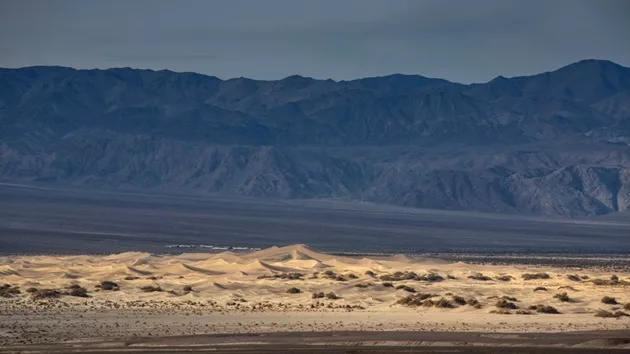
(BEATTY, Nev.) — The remnants of an ancient lake are still visible in Death Valley National Park after an inundation of rain last year left a significant amount of water in the famed Badwater Basin.
On Aug. 20, heavy precipitation from Hurricane Hilary — an event that prompted the first-ever tropical storm watch in California’s history — led to the pooling of several inches of water in Badwater Basin, where Lake Manly, an ancient lake that once was filled with water up to 700 feet deep during the Ice Ages, once stood, Abby Wines, park ranger at Death Valley National Park, told ABC News.
More than 2 inches of rain fell on Aug. 20 alone — more than the area, known for its desert landscape, typically sees in a year — according to the National Park Service.
The rain was so heavy it caused the closure of Death Valley National Park from Aug. 20 to Oct.15, the longest-ever in the park’s history, according to the NPS.
Since Death Valley is an internal basin, meaning the water does not drain out to sea, the remnants of the heavy rainfall remain — but it won’t be there forever, Wines said. Currently, the lake measures at multiple miles long, and about 2 miles wide. It is only a couple of inches deep and gets shallower by the day — with park rangers estimating that the lake could remain until the end of February.
The last time the lake filled up was in 2005, just before Wines moved to the region. It took about a week after it formed to dry up and has not filled up since, she said.
“We didn’t think it would be here anywhere near this long,” Wines said. “But if you were worried you might have missed it, you’re not too late. Come out here soon.”
The sight of the lake itself is enough to take one’s breath away, witnesses describe.
When the wind is calm, the water reflects the mountains surrounding Death Valley — the picturesque vista Badwater Basin is known for, Wines said. Tiffany Lin, a travel and hiking blogger in her mid-30s, described the water as having a “vibrant reflection” to it.
“It was perfectly clear,” said Lin, who drove from her home in Orange County, California, over Thanksgiving weekend to see the lake.
The flooding at its deepest was not nearly enough to kayak from end to end, Wines said. Lin described water deep enough to wade in toward the middle of the lake.
Because the climate is typically so hot and dry, any water left behind by rainfall tends to evaporate and leave behind salt flats in the basin, Wines said. But because the rain fell so fast and furiously, instead it drained down to the salt flats and filled it with water, she said.
At night, the full moon amplified the white hues in the salt, making the water appear brighter, Lin said.
“It just made for a really cool experience,” she said.
Badwater Basin, the home of the lowest sea level in North America at 282 feet below sea level, is one of the highlights for the parks 1.7 million visitors a year, Wines said.
Repeat visitors to Death Valley National Park are awestruck by the sight of a vast lake in an area that is typically bone dry, Wines said.
Lin described a stark different between her more recent visit and when she saw Badwater Basin in 2018, when it was “100% dry.”
“It’s really otherworldly,” Wines said.
Copyright © 2024, ABC Audio. All rights reserved.
